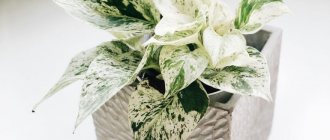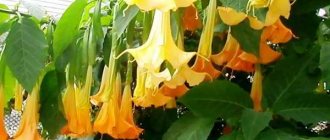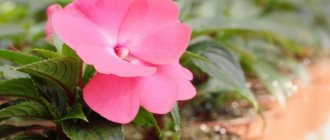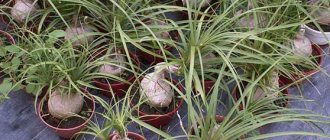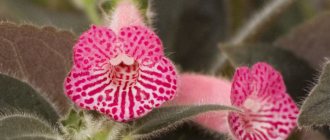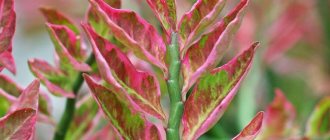Cute and clumsy, stubbornly adapting to the harshest conditions around him. Alien grace hidden under a cap of dense foliage. There are many more bright epithets that can be chosen, but flower growers, lovingly, call bocarnea much simpler and more down-to-earth: ponytail, elephant foot and bottle tree. Based, of course, on external characteristics!
This unusual palm tree has a bark that resembles rough elephant skin to the touch, a shape like a pot-bellied bottle, and long, narrow, belt-like leaves that resemble a ponytail gathered in a bun.
Varieties and photos
Bocarnea was first encountered in the central regions of Mexico and immediately amazed botanists with its size - in its homeland it reaches more than 10 meters in height and more than a meter in diameter . Its leaves are so strong that local residents used them to weave baskets and hats. However, the cultivated bokarnia abruptly lost the ability to stretch to such a grandiose size and turned into a plant convenient for growing and caring for at home, unpretentious in everyday life, but without losing its other external characteristics. Belongs to the Agave family.
Below are descriptions and photos of the main varieties of bocarnea, which can be cared for at home and in the botanical garden.
Recurved (Beaucarnea recurvata)
This variety has a bizarrely curved and very powerful trunk, reminiscent of a tree with a pot-bellied bulb near the ground. This thickening stores a supply of water collected during the short rainy season and stored during a long drought. According to scientists, the plant can survive on such a supply for a whole year! However, the trunk will lose all its power. The leaves of the variety are hard and narrow, lanceolate in shape. They also help in collecting moisture. The photo below shows a bent bocarnea (recurvata):
Longleaf (Beaucarnea longifolia)
It reaches a height of 2-3 meters, the trunk-branches grow from 3 to 5. The leaves are soft, dark green, up to 2.5 meters long and up to 3 cm wide. The trunk is covered with a corky bark of gray-brown color. You can see what the longleaf variety looks like in the photo below:
Compressed (Beaucarnea stricta)
Refers to a medium-sized species. It stretches up to 10 meters in height, branches from the very base. Leaves are 50-80 cm long and 0.8-1.5 cm wide, bluish-green. The leaves grow very densely and outwardly resemble spherical “brush brushes” , the tips of which can even prick you. Dew from such leaves does not evaporate, but rolls down it to the base of the trunk. In the photo below, the bocarnea variety is compressed:
The genus includes approximately 30 varieties, but only bocarnea reflexata (nolina) grows well at home, the rest do not take root well.
Bocarnea was first encountered and described in 1803 by the French botanist Andre Michaud, traveling through the hot Mexican territory, which was scarce and lacking in water. Somewhat later, the culture was discovered in the southern states of the United States.
Botanical characteristics
Bokarneya, or Nolina, in natural growing conditions reaches a height of up to 10 m with a trunk diameter of about 1 m.
When grown at home, it grows up to 2 m. It looks like a palm tree.
Due to its unusual appearance, beaucarnea is popularly called elephant foot, bottle tree and horse tail.
Description:
- the trunk looks like a swollen bottle, has a thickening at the bottom intended to accumulate moisture and nutritional components, is covered with cracked bark, the color is light brown or grayish;
- The root system is predominantly developed in breadth.
- leaves are narrow, erect or drooping, length 0.3-1.0 m, pointed ends, hard leathery surface, longitudinal veins clearly expressed, dark green color;
- blooms in small inflorescences, creamy in color, with a strong pleasant smell;
- The seeds are brown, round and flat in shape.
It blooms only in the wild or in greenhouse conditions. Flowering is observed in summer at high temperatures.
Care
Lighting
Bocarnea, like a true southerner, loves the sun and warmth. Therefore, prepare for it a cozy place that is illuminated by the sun - the plant will bask under its direct rays. This is that rare case when there is no need to organize any shading for the culture. Only in the light will a characteristic thickening form at the bottom of the trunk, while in the shade it will stretch upward. Windows - facing south, southwest, southeast.
Don’t forget to turn the container with the plant toward the light once a week, alternately : one side, then the other. These manipulations will protect the crop from bending the trunk. In winter, the pot lives well indoors, and in the summer, when the weather is good, the pot can be taken out to the balcony, loggia or garden.
Protect bocarney from drafts - it tolerates them so poorly that it may die. This also applies to long rains.
Temperature
Bocarnea is the same flower that is not afraid of either central heating radiators or dry air.
Temperature range - from +10 to +30 degrees: in summer for favorable growth maintain +20-25 degrees, in winter - +10-15. In winter, bokarnia rests, so start lowering the temperature gradually : from November, also reduce watering, gradually reducing it to “no”. During the hibernation period, the culture will gradually begin to consume the liquid and nutrients accumulated in the caudex. If this is not possible, simply eliminate fertilizing and reduce watering.
Be sure to organize additional lighting using a fluorescent or phytolamp: the bocarnea will snooze comfortably in the warmth and slowly continue to grow. Lighting should be year-round, without interruption, otherwise the “bottle” will not grow, and the crown will thin and wither.
Watering
The plant is negatively affected by humid air combined with low, about -10, temperatures. Therefore, if you have moisture-loving plants for which spraying is important, place them in different corners. Dry air is common for bocarney, but in a residential area it is unlikely to be comfortable for residents. Therefore, choose a compromise: moderate humidity.
Wipe the leaves with a damp sponge or cloth from time to time to remove accumulated dust and allow them to breathe. Spraying is required only during the hottest season, when central heating is on in the room.
When watering, be guided by the drying of the soil; overwatering leads to rotting of the trunk.
In summer it is enough to water every 5-7 days, in winter - every 2 weeks.
For a small plant, use bottom watering: place the container in a container with water and wait until the liquid saturates the soil from the bottom up. It’s easy to determine whether it’s possible to water or whether it’s too early. Dip your finger into the soil 3-4 cm: if it is dry, it’s time to water the plant. A large bokarnia can be watered in the usual way, from above, but make sure that no water gets on the trunk.
When choosing water for irrigation, give preference to purified water . Tap water contains so many harmful impurities (salts, heavy metals, chlorine, etc.) that it can destroy even such a patient plant as a succulent.
Be sure to leave it in a jar without a lid. You can also use rain water. The water temperature is only room temperature, since cold moisture is difficult to absorb by the roots and causes them to rot. In autumn, watering should be done in the first half of the day so that the substrate does not become too cold overnight, in spring and summer - in the evening to avoid evaporation of moisture in the light.
Top dressing
Bokarneya, accustomed to the meager “menu” of its distant homeland, does not need frequent feeding. The first feeding is carried out in the spring, as soon as the active growth phase begins, and the last - in October, before wintering. Frequency – once every 2 or 4 weeks, adding alternately organic matter and mineral fertilizer for decorative deciduous plants. From time to time, pamper the succulent with fertilizers with a high nitrogen content, but in low concentration. However, do not overuse! Otherwise, the flower will begin to grow too quickly and intensively, which is not typical for it at all; the bark will not have time to grow and will begin to burst and rot.
If there is a cat living in your house, get ready to repel the attacks of the fluffy monster on your bokarnya. Animals really love to feast on young green foliage. The reason is probably that it tastes like catnip.
Trimming
Bokarneya does not need pruning: its lush crown will form without your intervention. But it’s still worth removing dried ends and leaves.
Transfer
Bokarnia should be replanted every year while it is young, an adult plant (over 5 years old) - once every 3 years. This is done in April. Select a new pot 3-4 cm wider than the previous one .
When removing the plant from the pot, straighten the roots, shake off the soil and replant it in a new pot. When pouring soil on top, make sure that the thickening is above the ground. It cannot be buried! The first watering is carried out after 3-4 days.
The soil for bocarnea is needed, as for all succulents, dry and poorly nutritious, with an admixture of stones and sand, and a minimum of nitrogenous substances. The flower salon will offer you a mixture for succulents and cacti, but if it is difficult to find one, make it yourself.
Collect river sand (2 parts, coarse-grained if possible), peat (1 part) and leaf soil (1 part). The components should be disinfected : this can be done by steaming in the oven (an hour at a temperature of 100-120 degrees), steaming in a water bath (putting in a colander), freezing (for a day in the freezer), treating with a weak solution of potassium permanganate or using fungicides (insecticides) ).
Bokarna, like all succulents, needs high-quality drainage: expanded clay, fine gravel or broken brick. Layer – 1.5-2 cm.
Useful video
How to replant bokarnia after purchase?
Growing conditions
The desert succulent is not picky about conditions and will survive with minimal care.
He prefers a lighted place on a south or southwest window sill.
- In its natural environment it grows on rocky, infertile soil.
- A lightweight water-absorbing and breathable substrate designed for succulents is suitable for home growing.
Expanded clay or gravel is added to the prepared soil to increase aeration.
You can prepare the soil mixture yourself by mixing clay soil, humus, coarse sand, small pebbles (expanded clay mixture) in proportions 1:1:0.5:0.5.
Bocarnea requires special soil
For preventive protection against the development of fungal infections, it is recommended to add charcoal or activated carbon in a small amount.
Humidity
Humidity levels are not particularly important for a desert plant. The flower crop does not require spraying. Moistening along the foliage is possible, avoiding contact with the trunk.
Temperature
Nolina is a desert perennial. Optimal temperature for home growing:
- in summer - 20-25°C;
- in winter - not lower than 10°C.
In the summer season, it is recommended to take it out into the open air with protection from precipitation and drafts.
Lighting
It is not afraid of excess light, but is susceptible to direct sun. On the contrary, in the absence of sufficient illumination, it withers and dies. To avoid curvature of the trunk, the flower pot should be periodically turned clockwise by 45°C every 1-2 weeks.
The required daylight hours are 12 hours or more.
How does it bloom?
It is unlikely that you will be able to enjoy the spectacle of bocarnea blooming. In captivity it refuses to bloom. But if you manage to get to the hot Mexican regions, you will be able to admire a truly impressive spectacle when the plant releases a lush and very fragrant cap of buds collected in brushes. You can see what bocarnea blossoms look like in the photo below:
What is the optimal temperature for Beaucarnea?
In the summer, the plant grows actively, to create comfortable conditions, monitor the temperature: take Bokarneya out into the fresh air, and the room temperature should be about +20-25C.
In winter, +10-15C is considered a favorable temperature for the plant. Make sure the temperature drops gradually. If during the cold period the room temperature does not exceed 10 C, cancel watering.
Reproduction
Growing from seeds
- Soak the purchased seeds in a pale solution of potassium permanganate for a day or two (in Epin for 10 hours). During this time, bad seeds will rise to the surface. You can safely throw them away - don’t expect shoots from these.
- Plant suitable seed material in a prepared container with a substrate (perlite or river sand is poured on the bottom, a couple of centimeters of substrate for succulents with a small amount of activated carbon, clean sand on top). Before use, saturate the soil with Epin or Zircon.
- Cover the container with glass or plastic film, move it to a warm place (at least +25 degrees) and ventilate the greenhouse daily, while removing condensation.
- After waiting for the first shoots, carefully adjust the root so that it “looks” down. A month after the emergence of shoots, replace the film with a plastic cup, and when the shoots are 2 months old, separate them into separate containers. Plants can be transplanted to their permanent place of residence no earlier than six months later.
The pot is of no small importance - not everyone is suitable for such a powerful and spreading indoor plant as bocarnea! Since the roots of the crop grow wider rather than deeper, choose a container that is low but wide, with several drainage holes at the bottom.
Reproduction by shoots
- Cut off a healthy lateral shoot and place it in the Kornevin solution for a couple of hours. Powder the cut area with charcoal or activated carbon.
- Place the shoot in a glass of water and change it daily. The plant should be grown in a warm, well-lit place.
- Wait until the roots have grown properly (by at least half a centimeter), plant the shoot in a pot and care for it as usual. In such beakers, the caudex forms gradually and only with proper watering.
Remember that bokarnia grows very slowly in the house, and only at the age of 8-9 years does it grow to such a size that it can be placed on the floor in a tub.
Residents of Italy nicknamed the plant “smoke eater” for its ability to absorb large amounts of harmful compounds from the air (gas, smoke). That is why the crop is grown in office and work areas. In addition, it is believed that it has a good effect on the nervous system and strengthens the immune system.
Possible problems
If the leaves of nolina become smaller and turn pale, it is time to replant it, since the tree has become crowded.
Drying leaf tips means the tree is too dry; To eliminate the problem, you need to water the plant and wipe the leaves with a wet cloth.
This video contains some more useful tips on how to prevent problems with nolina:
When a tree's trunk becomes wrinkled after a long break in watering , it needs resuscitation. To do this, nolina is urgently placed in water for 1 hour, and then treated with a solution of succinic acid at a dosage of 0.1 percent.
Most pests are not able to gnaw through the leaves of a plant, but sometimes the following enemies can attack it:
- spider mite;
- scale insect;
- mealybug.
To get rid of parasites, you need to wash the leaves using a solution of laundry soap, which after 2 hours of exposure is washed off with clean water.
Diseases and Pests
- Have the leaves darkened, become limp and drooping? It's all about the lack of light! Move the plant to a brighter place or turn on a fluorescent lamp.
- Softening of the trunk occurs due to a large amount of moisture in the soil. Unfortunately, it is unlikely that it will be possible to save the bocarney.
- Drying of the trunk occurs due to lack of moisture. Adjust your watering schedule.
- Are the leaf blades starting to crack? You are feeding the plant too much nitrogen.
- Too dry air in the apartment can cause the tips of the leaves to dry out and brown spots appear on them.
With proper care, bokarneya almost never gets sick . However, it is not immune from the appearance of pests. Scale insects and spider mites often appear in dry air.
The algorithm for fighting both the first and the second is the same.
- If there are a lot of adult pests, collect them by hand. Since the size of an adult bocarnea does not allow it to be rinsed in the shower, soak a cotton swab in a soapy solution and wipe the outside of the leaves, trunk and caudex. Instead of soap, you can add ammonia, turpentine or hydrogen peroxide to the water. This may be enough if the pests have just appeared and have not had time to reproduce. Be sure to remove cobwebs, dried and severely damaged leaves.
- Treat bokarnia with a suitable preparation. To begin with, you can use a folk recipe: infusion of calendula, dandelion, decoction of dope, celandine, garlic or onion.
Of the biological products , “Agravertin”, “Vertimek”, “Fitoverm”, “Akarin” .
The last link in the pest control chain is acaricides and insecticides (Apollo, Oberon, Nisoran, Sunmite, Flumite, Aktara). When carrying out treatment, protect mucous membranes and skin from contact with drugs; after work, be sure to ventilate the room; if possible, carry out treatment outside.
Don’t forget to treat the pot, window sill, glass with a disinfectant, and wash the curtains if the plant touched them with leaves. Pests can also be found there.
Do not wipe the back side of the leaves with soapy water - the foam will clog the stomata (channels for air exchange). Make sure that soapy water does not get into the soil - this will damage the plant.
Crown formation
The form nolina will take depends on the conditions under which it is kept. Unlike other indoor exotic trees, the question is not how to prune bokarnia to give it the desired shape, but how to water it and where to place it. If you place the pot further from the light source and create extreme watering conditions, it will grow a “leg”. Placing it in a bright place and moisturizing more frequently will stimulate hair growth. The trunk can be completely straight. This adjustment can give the specimen the desired shape.
Bokarneya - purchasing a young palm tree
To sell nolina, florists are accustomed to placing several thematic palm trees in one container. However, it is better to purchase one copy. So good for practice and economical for arrangement.
A new tree requires replanting in a pot with fresh soil. However, at first it is recommended to place the bokarnia separately from other plants for at least a week. Perhaps the “migrant” is sick or has pests.
Flower transplant
The most optimal option for carrying out this procedure is transplantation once every three years. The pot should be small in size. Frequent replanting is not necessary and can cause significant damage in some cases. Nolina prefers to live in close quarters, and the soil should not be oversaturated with fertilizers. The soil is perfect for cacti, and if you add a little forest soil and sphagnum moss to it, then you won’t find a better habitat for bocarnea.
The main rule that you should always remember is proper and high-quality drainage. The pot must have large drainage holes. All this is necessary to avoid stagnation of water.
The flower can be replanted only after the roots have completely entwined the soil. Be sure to plant your pet at the same depth as it was previously. After moving the plant to another container, do not water it for three to four days.


